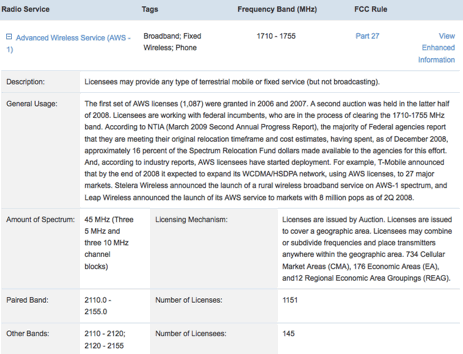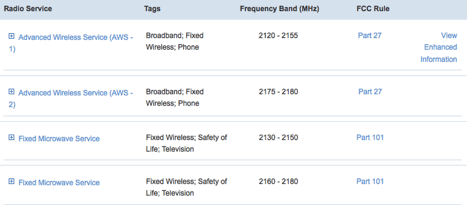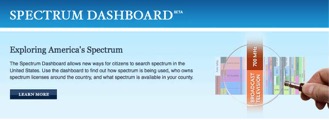alllocation table, spectrum management
New Spectrum Tools Available
25 03, 10 07:00 Filed in: NBP
This year two new tools have appeared to try to illuminate spectrum data what was previously available but hard to use. One is from a private party and the other is from FCC as a byproduct of the National Broadband Report.
The private effort is Unwanted Emissions, a website developed by a federal government spectrum manager who is active in IRAC matters. However, this is a personal effort that was done with the approval of his agency as it only contains public information. (“Unwanted emissions” is an inside IRAC joke for referring to FCC-authorized systems.)
The UE site has allocation table information and includes both ITU and domestic footnotes (US, G, and NG ) for the spectrum from to 9 kHz to 1000 GHz. There is even a useful guide to allocation information.
 “There’s an app for that” - a version of UE called
“There’s an app for that” - a version of UE called  “Allocations” exists as an iPhone/iPod touch App for $6.99.
“Allocations” exists as an iPhone/iPod touch App for $6.99.
Amusingly it has this one scathing review on the Apple app site from a ham, “If there was a lower rating than 1 star. i would want as low as I could. I been a ham radio op. for 40+ years this is the most useless app I’ve seen.” Well, for most hams it is probably pretty useless, but I suspect readers of this blog will have a different viewpoint.
Both UE and Allocations allow easy access to all footnotes - not so convenient in paper versions.
From FCC NBP team we get Spectrum Dashboard which has both allocation and licensing information - at least for some bands. It also gives your lines to FCC rule parts - unfortunately it gives you the GPO site for the appropriate part of the FCC Rules, e.g. Part 90. Where that band is in the Part 90 rules in up to you to find - it can be tough in many cases. It also only deals with 225-3700 MHz while UE covers the entire allocation table to 1000 GHz. Now for most commercial systems, 225-3700 is of primary interest and this is still the beta version, so let’s not be too harsh.
You can search for a spectrum block and get something that looks like the NTIA spectrum chart for that block that tell you what services are allocated. But the information is presented in allocation jargon such as “This band is used for the Mobile Satellite Service. This is allocated for both Federal and Non-Federal use” with no indication of what the use is called in normal jargon of if the band is actually in practical use. However, you can search more in a window alongside the NTIA-like chart and find what bands in a specific service are in the frequency range of interest and then you get a plain language description of what is happening such as:

The “View Enhanced Information” button then gets you a list of licenses in that band! This was available before in ULS, but this method is much easier. You can even get maps showing the amount of spectrum available in various counties.
A downside of the Dashboard is the focus on present allocations and the lack of any information on transitions in progress and pending actions. For example a search on 2120-2180 MHz gives the following information:
Want to buy a 2130-2150 Fixed license cheap? There is no hint at all about the AWS-3 band (2155-2175/80 MHz). No sign that the days of Fixed in this band are limited. No mention of the pending NPRM in Docket 07-195, let alone the NBP plans for this band.
In Spectrum Policy Task Force days we were trying to develop a web page with information about ongoing proceedings and WRC actions included with current allocations. Unfortunately, the resources were not available at that time. Hopefully the next version of the Dashboard will consider making this information available also.
Both websites are useful tools for the spectrum community and both need user feedback to help them evolve in the directions that users need. Feel free to post to this blog your comments to guide them and congratulations to the developers of both!
The private effort is Unwanted Emissions, a website developed by a federal government spectrum manager who is active in IRAC matters. However, this is a personal effort that was done with the approval of his agency as it only contains public information. (“Unwanted emissions” is an inside IRAC joke for referring to FCC-authorized systems.)
The UE site has allocation table information and includes both ITU and domestic footnotes (US, G, and NG ) for the spectrum from to 9 kHz to 1000 GHz. There is even a useful guide to allocation information.


Amusingly it has this one scathing review on the Apple app site from a ham, “If there was a lower rating than 1 star. i would want as low as I could. I been a ham radio op. for 40+ years this is the most useless app I’ve seen.” Well, for most hams it is probably pretty useless, but I suspect readers of this blog will have a different viewpoint.
Both UE and Allocations allow easy access to all footnotes - not so convenient in paper versions.
From FCC NBP team we get Spectrum Dashboard which has both allocation and licensing information - at least for some bands. It also gives your lines to FCC rule parts - unfortunately it gives you the GPO site for the appropriate part of the FCC Rules, e.g. Part 90. Where that band is in the Part 90 rules in up to you to find - it can be tough in many cases. It also only deals with 225-3700 MHz while UE covers the entire allocation table to 1000 GHz. Now for most commercial systems, 225-3700 is of primary interest and this is still the beta version, so let’s not be too harsh.
You can search for a spectrum block and get something that looks like the NTIA spectrum chart for that block that tell you what services are allocated. But the information is presented in allocation jargon such as “This band is used for the Mobile Satellite Service. This is allocated for both Federal and Non-Federal use” with no indication of what the use is called in normal jargon of if the band is actually in practical use. However, you can search more in a window alongside the NTIA-like chart and find what bands in a specific service are in the frequency range of interest and then you get a plain language description of what is happening such as:

The “View Enhanced Information” button then gets you a list of licenses in that band! This was available before in ULS, but this method is much easier. You can even get maps showing the amount of spectrum available in various counties.
A downside of the Dashboard is the focus on present allocations and the lack of any information on transitions in progress and pending actions. For example a search on 2120-2180 MHz gives the following information:

Want to buy a 2130-2150 Fixed license cheap? There is no hint at all about the AWS-3 band (2155-2175/80 MHz). No sign that the days of Fixed in this band are limited. No mention of the pending NPRM in Docket 07-195, let alone the NBP plans for this band.
In Spectrum Policy Task Force days we were trying to develop a web page with information about ongoing proceedings and WRC actions included with current allocations. Unfortunately, the resources were not available at that time. Hopefully the next version of the Dashboard will consider making this information available also.
Both websites are useful tools for the spectrum community and both need user feedback to help them evolve in the directions that users need. Feel free to post to this blog your comments to guide them and congratulations to the developers of both!
Comments




![Validate my RSS feed [Valid RSS]](valid-rss-rogers.png)

